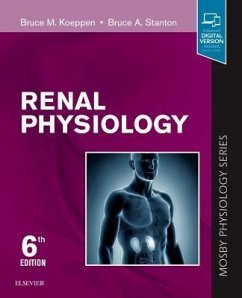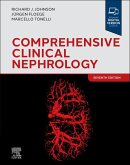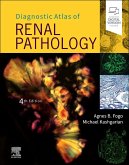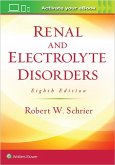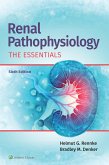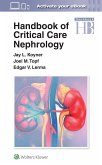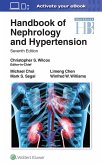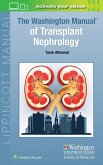Bruce M. Koeppen (Dean, Frank H. Netter MD School of Medicine, Quin, Bruce A. Stanton (Andrew C. Vail Professor, Microbiology, Immunolog
Renal Physiology
Mosby Physiology Series
Bruce M. Koeppen (Dean, Frank H. Netter MD School of Medicine, Quin, Bruce A. Stanton (Andrew C. Vail Professor, Microbiology, Immunolog
Renal Physiology
Mosby Physiology Series
- Broschiertes Buch
- Merkliste
- Auf die Merkliste
- Bewerten Bewerten
- Teilen
- Produkt teilen
- Produkterinnerung
- Produkterinnerung
Previous edition: Philadelphia: Elsevier Mosby, 2013.
Andere Kunden interessierten sich auch für
![Comprehensive Clinical Nephrology Comprehensive Clinical Nephrology]() Richard J. Johnson (Professor of Medicine, Division Chief, Tomas BeComprehensive Clinical Nephrology170,99 €
Richard J. Johnson (Professor of Medicine, Division Chief, Tomas BeComprehensive Clinical Nephrology170,99 €![Diagnostic Atlas of Renal Pathology Diagnostic Atlas of Renal Pathology]() Agnes B. Fogo (Medicine Professor of Pathology and Dir PediatricsDiagnostic Atlas of Renal Pathology183,99 €
Agnes B. Fogo (Medicine Professor of Pathology and Dir PediatricsDiagnostic Atlas of Renal Pathology183,99 €![Renal and Electrolyte Disorders Renal and Electrolyte Disorders]() Robert W. SchrierRenal and Electrolyte Disorders110,99 €
Robert W. SchrierRenal and Electrolyte Disorders110,99 €![Renal Pathophysiology Renal Pathophysiology]() Rennke, Helmut, MDRenal Pathophysiology43,99 €
Rennke, Helmut, MDRenal Pathophysiology43,99 €![Handbook of Critical Care Nephrology Handbook of Critical Care Nephrology]() Jay L. KoynerHandbook of Critical Care Nephrology72,99 €
Jay L. KoynerHandbook of Critical Care Nephrology72,99 €![Handbook of Nephrology and Hypertension Handbook of Nephrology and Hypertension]() Wilcox, Dr. Christopher S, MD PhDHandbook of Nephrology and Hypertension50,99 €
Wilcox, Dr. Christopher S, MD PhDHandbook of Nephrology and Hypertension50,99 €![The Washington Manual of Transplant Nephrology The Washington Manual of Transplant Nephrology]() Alhamad, Dr. Tarek, MDThe Washington Manual of Transplant Nephrology56,99 €
Alhamad, Dr. Tarek, MDThe Washington Manual of Transplant Nephrology56,99 €-
-
-
Produktdetails
- Produktdetails
- Mosby's Physiology Monograph
- Verlag: Elsevier - Health Sciences Division
- 6 ed
- Seitenzahl: 248
- Erscheinungstermin: 24. November 2018
- Englisch
- Abmessung: 231mm x 187mm x 13mm
- Gewicht: 496g
- ISBN-13: 9780323595681
- ISBN-10: 0323595685
- Artikelnr.: 53505880
- Herstellerkennzeichnung
- Libri GmbH
- Europaallee 1
- 36244 Bad Hersfeld
- gpsr@libri.de
- Mosby's Physiology Monograph
- Verlag: Elsevier - Health Sciences Division
- 6 ed
- Seitenzahl: 248
- Erscheinungstermin: 24. November 2018
- Englisch
- Abmessung: 231mm x 187mm x 13mm
- Gewicht: 496g
- ISBN-13: 9780323595681
- ISBN-10: 0323595685
- Artikelnr.: 53505880
- Herstellerkennzeichnung
- Libri GmbH
- Europaallee 1
- 36244 Bad Hersfeld
- gpsr@libri.de
Bruce Koeppen, founding dean of the Frank H. Netter MD School of Medicine at Quinnipiac, recently received two prestigious awards: honored by the Patient is U Foundation - a nonprofit that aims to encourage human communication in health care and support both patients and providers and the (LCME) Liaison Committee on Medical Education's 2019 Distinguished Service Award.
INTRODUCTION CHAPTER 1 PHYSIOLOGY OF BODY FLUIDS Objectives Concept of Steady-State Balance Physicochemical Properties of Electrolyte Solutions Molarity and Equivalence Osmosis and Osmotic Pressure Osmolarity and Osmolality Tonicity Oncotic Pressure Specific Gravity Volumes of Body Fluid Compartments Composition of Body Fluid Compartments Fluid Exchange between Body Fluid Compartments Capillary Fluid Exchange Cellular Fluid Exchange Summary Key Words and Concepts Self-Study Problems CHAPTER 2 STRUCTURE AND FUNCTION OF THE KIDNEYS Objectives Structure of the Kidneys Gross Anatomy Ultrastructure of the Nephron Ultrastructure of the Glomerulus Ultrastructure of the Juxtaglomerular Apparatus Innervation of the Kidneys Summary Key Words and Concepts Self-Study Problems CHAPTER 3 GLOMERULAR FILTRATION AND RENAL BLOOD FLOW Objectives Renal Clearance Glomerular Filtration Rate Glomerular Filtration Determinants of Ultrafiltrate Composition Dynamics of Ultrafiltration Renal Blood Flow Regulation of Renal Blood Flow and Glomerular Filtration Rate Sympathetic Nerves Angiotensin II Prostaglandins Nitric Oxide Endothelin Bradykinin Adenosine Natriuretic Peptides Adenosine Triphosphate Glucocorticoids Histamine Dopamine Summary Key Words and Concepts Self-Study Problems CHAPTER 4 RENAL TRANSPORT MECHANISMS: NaCl AND WATER ABSORPTION ALONG THE NEPHRON Objectives General Principles of Membrane Transport General Principles of Transepithelial Solute and Water Transport NaCl, Solute, and Water Reabsorption Along the Nephron Proximal Tubule Henle's Loop Distal Tubule and Collecting Duct Regulation of NaCl and Water Reabsorption Summary Key Words and Concepts Self-Study Problems CHAPTER 5 REGULATION OF BODY FLUID OSMOLALITY: REGULATION OF WATER BALANCE Objectives Arginine Vasopressin Osmotic Control of Arginine Vasopressin Secretion Hemodynamic Control of Arginine Vasopressin Secretion Arginine Vasopressin Actions on the Kidneys Thirst Renal Mechanisms for Dilution and Concentration of the Urine Medullary Interstitium Vasa Recta Function Assessment of Renal Diluting and Concentrating Ability Summary Key Words and Concepts Self-Study Problems CHAPTER 6 REGULATION OF EXTRACELLULAR FLUID VOLUME AND NaCl BALANCE Objectives Whole-Body Na+ Balance Concept of Effective Circulating Volume Volume-Sensing Systems Volume Sensors in the Low-Pressure Cardiopulmonary Circuit Volume Sensors in the High-Pressure Arterial Circuit Volume Sensor Signals Renal Sympathetic Nerves Renin-Angiotensin-Aldosterone System Natriuretic Peptides Arginine Vasopressin Control of Renal NaCl Excretion During Euvolemia Mechanisms for Maintaining Constant Na+ Delivery to the Distal Tubule in Euvolemia Regulation of Distal Tubule and Collecting Duct Na+ Reabsorption in Euvolemia Control of Na+ Excretion with Volume Expansion Control of Na+ Excretion with Volume Contraction Edema Alterations in Starling Forces Capillary Hydrostatic Pressure (Pc) Plasma Oncotic Pressure (
c) Lymphatic Obstruction Capillary Permeability Role of the Kidneys Summary Key Words and Concepts Self-Study Problems CHAPTER 7 REGULATION OF POTASSIUM BALANCE Objectives Overview of K+ Homeostasis Regulation of Plasma [K+] Epinephrine Insulin Aldosterone Alterations of Plasma [K+] Acid-Base Balance Plasma Osmolality Cell Lysis Exercise K+ Excretion by the Kidneys Cellular Mechanisms of K+ Transport by Principal Cells and Intercalated Cells in the Distal Tubule and Collecting Duct Regulation of K+ Secretion by the Distal Tubule and Collecting Duct Plasma [K+] Aldosterone Arginine Vasopressin Factors that Perturb K+ Excretion Flow of Tubular Fluid Acid-Base Balance Glucocorticoids Summary Key Words and Concepts Self-Study Problems CHAPTER 8 REGULATION OF ACID-BASE BALANCE Objectives
Buffer System Overview of Acid-Base Balance Renal Net Acid Excretion
Reabsorption Along the Nephron Regulation of H+ Secretion Formation of New Response to Acid-Base Disorders Extracellular and Intracellular Buffers Respiratory Compensation Renal Compensation Simple Acid-Base Disorders Metabolic Acidosis Metabolic Alkalosis Respiratory Acidosis Respiratory Alkalosis Analysis of Acid-Base Disorders Summary Key Words and Concepts Self-Study Problems CHAPTER 9 REGULATION OF CALCIUM AND PHOSPHATE HOMEOSTASIS Objectives Calcium Overview of Ca++ Homeostasis Ca++ Transport Along the Nephron Regulation of Urinary Ca++ Excretion Calcium-Sensing Receptor Phosphate Overview of Pi Homeostasis Pi Transport Along the Nephron Regulation of Urinary Pi Excretion Integrative Review of Parathyroid Hormone and Calcitriol on Ca++ and Pi Homeostasis Summary Key Words and Concepts Self-Study Problems CHAPTER 10 PHYSIOLOGY OF DIURETIC ACTION Objectives General Principles of Diuretic Action Sites of Action of Diuretics Response of Other Nephron Segments Adequate Delivery of Diuretics to Their Site of Action Volume of the Extracellular Fluid Diuretic Braking Phenomenon Mechanisms of Action of Diuretics Osmotic Diuretics Carbonic Anhydrase Inhibitors Loop Diuretics Thiazide Diuretics K+-Sparing Diuretics Aquaretics Effect of Diuretics on the Excretion of Water and Other Solutes Solute-Free Water K+ Excretion HCO
Excretion Ca++ and Pi Excretion Summary Key Words and Concepts Self-Study Problems ADDITIONAL READING A P P E N D I X A INTEGRATIVE CASE STUDIES A P P E N D I X B NORMAL LABORATORY VALUES A P P E N D I X C NEPHRON FUNCTION A P P E N D I X D ANSWERS TO SELF-STUDY PROBLEMS A P P E N D I X E ANSWERS TO INTEGRATIVE CASE STUDIES A P P E N D I X F REVIEW EXAMINATION APPENDIX G ANSWERS TO REVIEW EXAMINATION INDEX
c) Lymphatic Obstruction Capillary Permeability Role of the Kidneys Summary Key Words and Concepts Self-Study Problems CHAPTER 7 REGULATION OF POTASSIUM BALANCE Objectives Overview of K+ Homeostasis Regulation of Plasma [K+] Epinephrine Insulin Aldosterone Alterations of Plasma [K+] Acid-Base Balance Plasma Osmolality Cell Lysis Exercise K+ Excretion by the Kidneys Cellular Mechanisms of K+ Transport by Principal Cells and Intercalated Cells in the Distal Tubule and Collecting Duct Regulation of K+ Secretion by the Distal Tubule and Collecting Duct Plasma [K+] Aldosterone Arginine Vasopressin Factors that Perturb K+ Excretion Flow of Tubular Fluid Acid-Base Balance Glucocorticoids Summary Key Words and Concepts Self-Study Problems CHAPTER 8 REGULATION OF ACID-BASE BALANCE Objectives
Buffer System Overview of Acid-Base Balance Renal Net Acid Excretion
Reabsorption Along the Nephron Regulation of H+ Secretion Formation of New Response to Acid-Base Disorders Extracellular and Intracellular Buffers Respiratory Compensation Renal Compensation Simple Acid-Base Disorders Metabolic Acidosis Metabolic Alkalosis Respiratory Acidosis Respiratory Alkalosis Analysis of Acid-Base Disorders Summary Key Words and Concepts Self-Study Problems CHAPTER 9 REGULATION OF CALCIUM AND PHOSPHATE HOMEOSTASIS Objectives Calcium Overview of Ca++ Homeostasis Ca++ Transport Along the Nephron Regulation of Urinary Ca++ Excretion Calcium-Sensing Receptor Phosphate Overview of Pi Homeostasis Pi Transport Along the Nephron Regulation of Urinary Pi Excretion Integrative Review of Parathyroid Hormone and Calcitriol on Ca++ and Pi Homeostasis Summary Key Words and Concepts Self-Study Problems CHAPTER 10 PHYSIOLOGY OF DIURETIC ACTION Objectives General Principles of Diuretic Action Sites of Action of Diuretics Response of Other Nephron Segments Adequate Delivery of Diuretics to Their Site of Action Volume of the Extracellular Fluid Diuretic Braking Phenomenon Mechanisms of Action of Diuretics Osmotic Diuretics Carbonic Anhydrase Inhibitors Loop Diuretics Thiazide Diuretics K+-Sparing Diuretics Aquaretics Effect of Diuretics on the Excretion of Water and Other Solutes Solute-Free Water K+ Excretion HCO
Excretion Ca++ and Pi Excretion Summary Key Words and Concepts Self-Study Problems ADDITIONAL READING A P P E N D I X A INTEGRATIVE CASE STUDIES A P P E N D I X B NORMAL LABORATORY VALUES A P P E N D I X C NEPHRON FUNCTION A P P E N D I X D ANSWERS TO SELF-STUDY PROBLEMS A P P E N D I X E ANSWERS TO INTEGRATIVE CASE STUDIES A P P E N D I X F REVIEW EXAMINATION APPENDIX G ANSWERS TO REVIEW EXAMINATION INDEX
INTRODUCTION CHAPTER 1 PHYSIOLOGY OF BODY FLUIDS Objectives Concept of Steady-State Balance Physicochemical Properties of Electrolyte Solutions Molarity and Equivalence Osmosis and Osmotic Pressure Osmolarity and Osmolality Tonicity Oncotic Pressure Specific Gravity Volumes of Body Fluid Compartments Composition of Body Fluid Compartments Fluid Exchange between Body Fluid Compartments Capillary Fluid Exchange Cellular Fluid Exchange Summary Key Words and Concepts Self-Study Problems CHAPTER 2 STRUCTURE AND FUNCTION OF THE KIDNEYS Objectives Structure of the Kidneys Gross Anatomy Ultrastructure of the Nephron Ultrastructure of the Glomerulus Ultrastructure of the Juxtaglomerular Apparatus Innervation of the Kidneys Summary Key Words and Concepts Self-Study Problems CHAPTER 3 GLOMERULAR FILTRATION AND RENAL BLOOD FLOW Objectives Renal Clearance Glomerular Filtration Rate Glomerular Filtration Determinants of Ultrafiltrate Composition Dynamics of Ultrafiltration Renal Blood Flow Regulation of Renal Blood Flow and Glomerular Filtration Rate Sympathetic Nerves Angiotensin II Prostaglandins Nitric Oxide Endothelin Bradykinin Adenosine Natriuretic Peptides Adenosine Triphosphate Glucocorticoids Histamine Dopamine Summary Key Words and Concepts Self-Study Problems CHAPTER 4 RENAL TRANSPORT MECHANISMS: NaCl AND WATER ABSORPTION ALONG THE NEPHRON Objectives General Principles of Membrane Transport General Principles of Transepithelial Solute and Water Transport NaCl, Solute, and Water Reabsorption Along the Nephron Proximal Tubule Henle's Loop Distal Tubule and Collecting Duct Regulation of NaCl and Water Reabsorption Summary Key Words and Concepts Self-Study Problems CHAPTER 5 REGULATION OF BODY FLUID OSMOLALITY: REGULATION OF WATER BALANCE Objectives Arginine Vasopressin Osmotic Control of Arginine Vasopressin Secretion Hemodynamic Control of Arginine Vasopressin Secretion Arginine Vasopressin Actions on the Kidneys Thirst Renal Mechanisms for Dilution and Concentration of the Urine Medullary Interstitium Vasa Recta Function Assessment of Renal Diluting and Concentrating Ability Summary Key Words and Concepts Self-Study Problems CHAPTER 6 REGULATION OF EXTRACELLULAR FLUID VOLUME AND NaCl BALANCE Objectives Whole-Body Na+ Balance Concept of Effective Circulating Volume Volume-Sensing Systems Volume Sensors in the Low-Pressure Cardiopulmonary Circuit Volume Sensors in the High-Pressure Arterial Circuit Volume Sensor Signals Renal Sympathetic Nerves Renin-Angiotensin-Aldosterone System Natriuretic Peptides Arginine Vasopressin Control of Renal NaCl Excretion During Euvolemia Mechanisms for Maintaining Constant Na+ Delivery to the Distal Tubule in Euvolemia Regulation of Distal Tubule and Collecting Duct Na+ Reabsorption in Euvolemia Control of Na+ Excretion with Volume Expansion Control of Na+ Excretion with Volume Contraction Edema Alterations in Starling Forces Capillary Hydrostatic Pressure (Pc) Plasma Oncotic Pressure (
c) Lymphatic Obstruction Capillary Permeability Role of the Kidneys Summary Key Words and Concepts Self-Study Problems CHAPTER 7 REGULATION OF POTASSIUM BALANCE Objectives Overview of K+ Homeostasis Regulation of Plasma [K+] Epinephrine Insulin Aldosterone Alterations of Plasma [K+] Acid-Base Balance Plasma Osmolality Cell Lysis Exercise K+ Excretion by the Kidneys Cellular Mechanisms of K+ Transport by Principal Cells and Intercalated Cells in the Distal Tubule and Collecting Duct Regulation of K+ Secretion by the Distal Tubule and Collecting Duct Plasma [K+] Aldosterone Arginine Vasopressin Factors that Perturb K+ Excretion Flow of Tubular Fluid Acid-Base Balance Glucocorticoids Summary Key Words and Concepts Self-Study Problems CHAPTER 8 REGULATION OF ACID-BASE BALANCE Objectives
Buffer System Overview of Acid-Base Balance Renal Net Acid Excretion
Reabsorption Along the Nephron Regulation of H+ Secretion Formation of New Response to Acid-Base Disorders Extracellular and Intracellular Buffers Respiratory Compensation Renal Compensation Simple Acid-Base Disorders Metabolic Acidosis Metabolic Alkalosis Respiratory Acidosis Respiratory Alkalosis Analysis of Acid-Base Disorders Summary Key Words and Concepts Self-Study Problems CHAPTER 9 REGULATION OF CALCIUM AND PHOSPHATE HOMEOSTASIS Objectives Calcium Overview of Ca++ Homeostasis Ca++ Transport Along the Nephron Regulation of Urinary Ca++ Excretion Calcium-Sensing Receptor Phosphate Overview of Pi Homeostasis Pi Transport Along the Nephron Regulation of Urinary Pi Excretion Integrative Review of Parathyroid Hormone and Calcitriol on Ca++ and Pi Homeostasis Summary Key Words and Concepts Self-Study Problems CHAPTER 10 PHYSIOLOGY OF DIURETIC ACTION Objectives General Principles of Diuretic Action Sites of Action of Diuretics Response of Other Nephron Segments Adequate Delivery of Diuretics to Their Site of Action Volume of the Extracellular Fluid Diuretic Braking Phenomenon Mechanisms of Action of Diuretics Osmotic Diuretics Carbonic Anhydrase Inhibitors Loop Diuretics Thiazide Diuretics K+-Sparing Diuretics Aquaretics Effect of Diuretics on the Excretion of Water and Other Solutes Solute-Free Water K+ Excretion HCO
Excretion Ca++ and Pi Excretion Summary Key Words and Concepts Self-Study Problems ADDITIONAL READING A P P E N D I X A INTEGRATIVE CASE STUDIES A P P E N D I X B NORMAL LABORATORY VALUES A P P E N D I X C NEPHRON FUNCTION A P P E N D I X D ANSWERS TO SELF-STUDY PROBLEMS A P P E N D I X E ANSWERS TO INTEGRATIVE CASE STUDIES A P P E N D I X F REVIEW EXAMINATION APPENDIX G ANSWERS TO REVIEW EXAMINATION INDEX
c) Lymphatic Obstruction Capillary Permeability Role of the Kidneys Summary Key Words and Concepts Self-Study Problems CHAPTER 7 REGULATION OF POTASSIUM BALANCE Objectives Overview of K+ Homeostasis Regulation of Plasma [K+] Epinephrine Insulin Aldosterone Alterations of Plasma [K+] Acid-Base Balance Plasma Osmolality Cell Lysis Exercise K+ Excretion by the Kidneys Cellular Mechanisms of K+ Transport by Principal Cells and Intercalated Cells in the Distal Tubule and Collecting Duct Regulation of K+ Secretion by the Distal Tubule and Collecting Duct Plasma [K+] Aldosterone Arginine Vasopressin Factors that Perturb K+ Excretion Flow of Tubular Fluid Acid-Base Balance Glucocorticoids Summary Key Words and Concepts Self-Study Problems CHAPTER 8 REGULATION OF ACID-BASE BALANCE Objectives
Buffer System Overview of Acid-Base Balance Renal Net Acid Excretion
Reabsorption Along the Nephron Regulation of H+ Secretion Formation of New Response to Acid-Base Disorders Extracellular and Intracellular Buffers Respiratory Compensation Renal Compensation Simple Acid-Base Disorders Metabolic Acidosis Metabolic Alkalosis Respiratory Acidosis Respiratory Alkalosis Analysis of Acid-Base Disorders Summary Key Words and Concepts Self-Study Problems CHAPTER 9 REGULATION OF CALCIUM AND PHOSPHATE HOMEOSTASIS Objectives Calcium Overview of Ca++ Homeostasis Ca++ Transport Along the Nephron Regulation of Urinary Ca++ Excretion Calcium-Sensing Receptor Phosphate Overview of Pi Homeostasis Pi Transport Along the Nephron Regulation of Urinary Pi Excretion Integrative Review of Parathyroid Hormone and Calcitriol on Ca++ and Pi Homeostasis Summary Key Words and Concepts Self-Study Problems CHAPTER 10 PHYSIOLOGY OF DIURETIC ACTION Objectives General Principles of Diuretic Action Sites of Action of Diuretics Response of Other Nephron Segments Adequate Delivery of Diuretics to Their Site of Action Volume of the Extracellular Fluid Diuretic Braking Phenomenon Mechanisms of Action of Diuretics Osmotic Diuretics Carbonic Anhydrase Inhibitors Loop Diuretics Thiazide Diuretics K+-Sparing Diuretics Aquaretics Effect of Diuretics on the Excretion of Water and Other Solutes Solute-Free Water K+ Excretion HCO
Excretion Ca++ and Pi Excretion Summary Key Words and Concepts Self-Study Problems ADDITIONAL READING A P P E N D I X A INTEGRATIVE CASE STUDIES A P P E N D I X B NORMAL LABORATORY VALUES A P P E N D I X C NEPHRON FUNCTION A P P E N D I X D ANSWERS TO SELF-STUDY PROBLEMS A P P E N D I X E ANSWERS TO INTEGRATIVE CASE STUDIES A P P E N D I X F REVIEW EXAMINATION APPENDIX G ANSWERS TO REVIEW EXAMINATION INDEX

